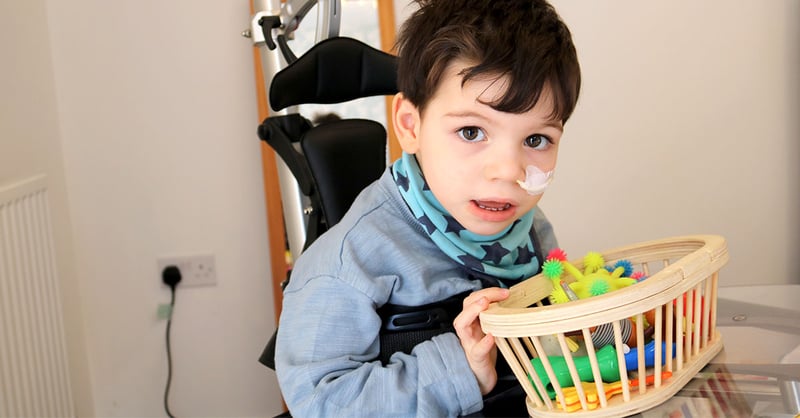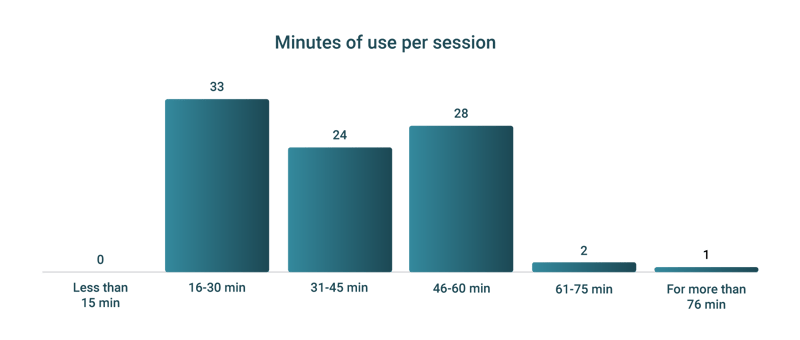Survey: Perceived benefits of using the Innowalk, a dynamic stander?


Innowalk is a dynamic stander which enables activity for people with severe disabilities. We asked our customers in the UK and Ireland how they are using the equipment and what are the benefits of the activity.
In this article you will get an overview of the results from a customer survey performed among our Innowalk users in the UK & Ireland in 2022. There are 207 active Innowalk users and 43% answered the survey. We will share results on the following:
- Who is using the Innowalk?
- How often is the equipment used?
- What are the perceived benefits of dynamic standing?
- How satisfied are the customers with the device and Made for Movement service?
The survey was answered by parents/caretakers of people who are using the Innowalk. The results are an expression of their subjective experience with the equipment and not based on objective measurements.
Who is using the Innowalk?
The majority of those using the dynamic stander are children and young people with cerebral palsy (75%). Other diagnoses are also represented such as acquired brain injury, neuromuscular diseases, spinal injury and other more severe syndromes. Ninety percent of the participants are non-ambulant, representing the Gross Motor Function Classification (GMFCS) IV and V. The age span among the UK/IRL users are wide and cover children from 2 years and to above 17 years of age.
This representation correlates well with other countries, such as Norway, Sweden and Germany where the Innowalk is also widely used. The uniqueness of the device is the ability to allow people with severe disabilities from an early age (1-2 years) into a supported standing position with weight-bearing and at the same time add repetitive movement of the legs. Often the Innowalk is compared with a cross-trainer, but with the additional postural support needed to offer stability, alignment and safety for those who are unable to stand and walk by themselves.
How often is the equipment used?
The parents who answered the survey on the behalf of their children described frequency of Innowalk usage that ranged from 2 to 7 or more sessions per week. The majority used it 4 times per week. Time per session varied from 16 min to 60 min, with 38% of respondents using it 16-30 minutes per session versus 32% using it for 46-60 minutes per session.

Looking into research articles, the recommendations for use during one study was every day (7 days a week), but on average the children were exercising in the device for 5 days a week during the study period. More studies in the future are needed to enable standard recommendations for dynamic standing. Nevertheless, there is some guidelines we can use as a baseline for discussing individual recommendations based on goal and expected outcomes. For example, WHO recommends 60 min of physical activity for children on a daily basis. Standing in the Innowalk has proven to be physical activity and can be used on a daily basis to meet activity recommendations and reduce sedentary behaviour.
Studies have shown that standing may have a positive impact on bone mineral density (BMD) when standing 5 times per week for 60-90 min per session, and Range of Motion (ROM) appears to be affected when standing 5 times per week for 45-60 min per session. So, if the goal for the child is to improve BMD and ROM you can use these recommendations as a guideline.
The above mentioned study found that spasticity is positively affected after 30-60 min of dynamic standing, but it seems to be an acute effect, meaning it does not last for days. Therefore, if you aim to reduce spasticity to utilise this effect in other daily activities, it may be beneficial to perform dynamic standing on a daily basis.
Read also: Static or Dynamic standing? New study reveals interesting data.
What are the perceived benefits of dynamic standing?
Parents were asked to rate to what extend they found that the activity in the Innowalk had good/very good effect or no/small effect on different parameters. 52-75% answered that their child had good/very good effect on bowel function (65%), blood circulation (54%), respiration (52%), endurance (77%), joint range of motion (75%), muscle strength (71%) and alertness/engagement (56%). They did not see any effect or small effects on communication (65%), or sitting, standing and walking ability (57%, 48%,67%).
We also asked parents to answer how much they agreed or disagreed with the following statements:
|
Statement |
Totally/partially disagree |
Neither agree nor disagree |
Partially/totally agree |
|
The Innowalk helps to improve my child’s motor function |
7% |
25% |
68% |
|
The Innowalk helps to maintain my child’s motor function |
6% |
17% |
77% |
|
The Innowalk positively affects my child’s quality of life |
9% |
5% |
86% |
|
My child enjoys using the Innowalk |
8% |
9% |
83% |
|
The device has shown value for money |
13% |
18% |
69% |
We are very pleased to discover that 86% answered “The Innowalk positively affects my child’s quality of life”. Contributing to improved quality of life to people who are living with a severe disability is one of Made for Movement’s main purposes.
In a study from Sweden where static and dynamic standing were compared, they also found that dynamic standing in the Innowalk significantly improved the quality of life for children with severe CP. You can read more about the study here: New study: Activity in the Innowalk improves quality of life (QoL)
Eighty three percent also stated that their child enjoys using the Innowalk. We realise the importance of children finding joy in physical activity. This is motivating both for the child as well as the family and encourages continuity in their daily training activities.
How satisfied are the customers with the device and Made for Movement’s service level?
Seventy eight percent state that they are very satisfied with the Innowalk and 19% somewhat satisfied. Only 2% were not satisfied.
When we evaluate the satisfaction with the service level and support by Made for Movement, 84% answered that they are very satisfied and 13% somewhat satisfied.
People with severe disability have profoundly individual needs when it comes to assistive devices and we strive to deliver excellent service and support by qualified people, to ensure safe and secure therapy, handling and training. Therefore, we deliver an Uptime service program. You can read more about the program here and learn more about “How to adapt your Innowalk” in this article.
We at Made for Movement want to thank all the families who spent time answering our survey. We are extremely grateful for the insight and knowledge you have shared with us. Thank you.

Rikke Damkjær Moen brings many years of experience as clinical physiotherapist to the Made for Movement team. Her mission is to ensure that everybody, regardless of mobility problems, should be able to experience the joy and health benefits of physical activity. As our Medical Manager, Rikke is passionate about sharing knowledge so that individuals with special needs, families, and clinicians can discover the possibilities and solutions provided by Made for Movement.
A severe accident during a hockey game resulted in 35-year-old Tobias breaking his neck and becoming paralysed from the armpits down....
A disability entails the loss of, damage to, or deviation from bodily or psychological functions, in the form of mental, physical,...
The Neurological Interdisciplinary Treatment Centre NiB (Neurologisches Interdisziplinäres Behandlungszentrum) is an innovative...
Hear from us from time to time and learn new things